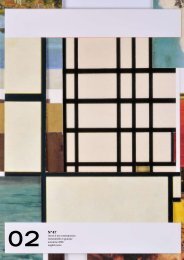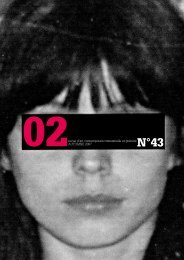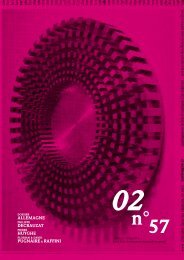par Céline Chazalviel
par Céline Chazalviel
par Céline Chazalviel
Create successful ePaper yourself
Turn your PDF publications into a flip-book with our unique Google optimized e-Paper software.
Le Corbusier<br />
Modulor 1950<br />
Schéma des mesures/<br />
Diagram of measurments<br />
Le Corbusier<br />
Modulor 1950<br />
Schéma des mesures/Diagram of measurments<br />
“The line between art and life should be kept<br />
as fluid, and perhaps indistinct, as possible.”<br />
48 49<br />
1<br />
This statement, pronounced by Allan Kaprow in<br />
1965, resonates with what has become a very<br />
well known feminist slogan from the same era:<br />
“The personal is political” 2 —attributed to Carol<br />
Hanisch in 1969—which incited an extension<br />
of the feminist struggle into every precinct of<br />
life, from the social body to the intimate one.<br />
From the perspective of the conceptual and<br />
politically engaged artists of the time, one of<br />
the consequences of erasing the boundaries<br />
between art and non-art—as with those<br />
between the personal and the political—is<br />
that art becomes a domain inse<strong>par</strong>able from<br />
the personal and the political. Today, still, art<br />
is permeable by the state of society and does<br />
not limit itself to the role of a symbolic mirror.<br />
This proposition on the confusion of art and<br />
life orients the introduction to an application<br />
of the feminist debate to art and paves the way<br />
for the more developed conception of cultural<br />
studies—so long ignored by the French “art<br />
world,” but responsible for a few notable intrusions3<br />
. This discipline, which refuses to detach<br />
artistic problems from social and cultural ones,<br />
examines a work’s context alongside its author,<br />
and applies itself to a critique of works, actors,<br />
and institutions. Cultural studies opposes<br />
itself to a conception of art of universal scope,<br />
one that sublimates creation and freezes it in<br />
essentialist terms. It denounces the latter view’s<br />
ignorance, be it naive or feigned, in regards to<br />
this so-called universal scope, which ultimately<br />
reaffirms the canons of what Christine Delphy<br />
has tagged the “famous masculine-neutral,” 4<br />
transforming its uniformizing and (not so)<br />
asexual idealism into a sort of cache-sexe for<br />
questions of gender.<br />
Since 1972, when Anne Oakley differentiated<br />
sex (biological) from gender (culturally<br />
constructed), these terms—like their relations—<br />
have been subject to continual reevaluation;<br />
nevertheless, this distinction has contributed<br />
greatly to deconstructing the differences<br />
between the sexes, designating them as socially<br />
constructed—or variable and contextual, as<br />
opposed to natural and immutable. Today, it<br />
structures the politics of the European Commission’s<br />
equal opportunity policies, where the<br />
notion of “gender mainstreaming” 5 might be extended to the artistic institution<br />
as a kind of political guardrail.<br />
NuMbers taLK (to us)<br />
We saw it just a little while ago with La Force<br />
de l’art 02<br />
—or the<br />
integration of feminine analyses into general<br />
politics—has gained new currency. In this<br />
contemporary landscape, we can ask ourselves<br />
whether the concept of gender mainstreaming<br />
6 ; despite its generous and legitimate<br />
ambition “to present, in all its richness and<br />
diversity, a engaged panorama of artistic<br />
creation in France, free from distinctions of<br />
generation, gender, or nationality,” 7 the French<br />
Triennial’s female-to-male ratio left a lot to be<br />
desired. According to the authors of the text “La<br />
Faiblesse de l’art” 8 tions (art centers, Fracs, and contemporary<br />
art museums alike<br />
, only 7 out of 42 artists, or<br />
16% percent of the <strong>par</strong>ticipants, were female,<br />
reminding us that women are still all too often<br />
confined to an underrepresented minority. But<br />
this exhibition, which trumpets its objective to<br />
offer a representative sampling of the French<br />
art world, fulfills at least <strong>par</strong>t of its aim. For the<br />
exhibition is indeed representative, but of an<br />
exemplary lack of thought on the <strong>par</strong>t of the<br />
curators who—embarrassing coincidence—<br />
happen to be male and who seem, in their<br />
happy fraternity, to have agreed unanimously<br />
on the number of women included and to have<br />
forgotten to direct their attention to society’s<br />
less visible inroads of creation. For it is not in<br />
the realm of the female artists and the “force” of<br />
their work that the shoe rubs, but the attention<br />
that actors in the art world in general pay to<br />
these questions, often too quickly relegated<br />
to the rank of brute statistics, which have<br />
nothing artistic about them at all.<br />
We might also legitimately question the degree<br />
to which these actors, male and female alike,<br />
are truly invested in the question of diversity—<br />
attention and militancy, after all, are worlds<br />
a<strong>par</strong>t. But in this regard, resistance arises<br />
from both sides of the sexual barrier, as we can<br />
see from the entirely female cast of authors<br />
responsible for the aforementioned text,<br />
to whom I responded with my own catchy<br />
motto: “100% with us!” But who is this “We,<br />
the women” who presupposes this text? Does<br />
it designate a “They, the men?” Meanwhile,<br />
neither the female curators nor the women in<br />
command of institutions, even at the Ministry of<br />
Culture, have ever demonstrated much altruism<br />
towards their peers; it will certainly be a long<br />
time coming before they adopt any spirit of<br />
female solidarity. So even if we have observed<br />
a certain feminization of the executive board<br />
of the French cultural institution in recent<br />
years—38 female directors, out of 98 institu-<br />
9 ), it is time to dissociate<br />
women and feminism. At the same time, 39%<br />
of women at the head of artistic institutions is<br />
a record high in com<strong>par</strong>ison with the effects<br />
of equal opportunity movements in politics;<br />
despite the laws of 2000 and 2007, women<br />
represent only a marginal fraction of the<br />
French administration: 12% of the National<br />
Assembly in 2002, and barely 20% following<br />
the legislation of June 200710 .<br />
“aNd 100% shes?” aNd 100% hes? aNd 100%<br />
theM? or Not?<br />
To remain with the question of statistics for a<br />
moment, “La Faiblesse de l’art” uses numbers<br />
as a useful shortcut between two, almost<br />
contemporaneous institutional exhibitions,<br />
pointing to a wide discrepancy in their number<br />
of female artists: whereas La Force de l’art 02<br />
is only %16 female, elles@centrepompidou11 is<br />
a whopping 100%! Here, the text’s numerical<br />
argument revives one of the key features of the<br />
latter exhibition’s publicity campaign: “At the<br />
Centre Pompidou, women represent 17.7% of<br />
the artists in the museum’s collection.” “This<br />
new presentation of the collection is devoted<br />
to them 100%.”<br />
Following Dionysiac, 12 which was 100% male, was<br />
this exhibition featuring “the female artists in<br />
the Centre Pompidou’s collection” simply trying<br />
to turn back the dial to zero? But Dionysiac was<br />
exemplary, not so much for its numbers (13<br />
artists, 13 men: pretty reasonable) but because<br />
of its pointedly masculine theme. With all male<br />
exhibition, Christine Macel, who subsequently<br />
confirmed her design in a famous interview<br />
with Jean-Marc Bustamante, 13 attempted<br />
to associate ejaculatory power with creative<br />
force, “naturally” excluding women from this<br />
domain! This masculine dimension was therefore<br />
not a “lack of thought”, but the foundation<br />
of the curatorial project itself, set from the<br />
perspective of the masculine imaginary, “a<br />
state of mind, a sensibility shared by the artists<br />
presented.” Let us not forget Africa Remix14 « La ligne entre l’art et la vie devrait être aussi<br />
fluide et peut-être même aussi vague que possible »<br />
while we’re at it, “the first large exhibition of<br />
contemporary African art”, which counted 100%<br />
African artists or artists of African origin. The<br />
nuance of elles@pompidou lies in its nature as<br />
an inspection of the premises: the resurrection<br />
of that <strong>par</strong>t of the museum’s collection “with<br />
elles alone”, to quote Camille Morineau, who<br />
explains the exhibition in terms of a “question<br />
1<br />
Ce statement d’Allan Kaprow de 1965 résonne<br />
avec ce qui est devenu un slogan féministe<br />
bien connu de la même époque : « Le personnel<br />
est politique » 2 – attribué à Carol Hanisch en<br />
1969 – et qui incitait à étendre le domaine<br />
de la lutte féministe à toutes les échelles de<br />
la vie, du corps social au corps intime. Dans<br />
la perspective d’artistes conceptuel(le)s et<br />
de militant(e)s de ces années, une des conséquences<br />
de l’effacement des frontières entre<br />
art et non-art, comme entre le personnel et le<br />
politique, est que l’art n’est un domaine sé<strong>par</strong>é<br />
ni du personnel, ni du politique. Aujourd’hui<br />
encore, l’art est perméable à l’état d’une<br />
société et ne se limite pas à en être un miroir<br />
symbolique. Cette proposition sur l’art et la<br />
vie confondus préside à l’introduction d’un<br />
débat féministe appliqué à l’art et s’associe à<br />
la conception plus articulée des cultural studies<br />
(si longtemps ignorées du « monde de l’art »<br />
français, mais qui y font quelques percées3 ).<br />
Celle-ci, ne dissociant pas les problématiques<br />
artistiques d’autres, sociales et culturelles,<br />
tient compte du contexte d’ap<strong>par</strong>ition d’une<br />
œuvre comme de son auteur et s’applique au<br />
sein d’une critique des œuvres, des acteurs<br />
et des institutions. Cette approche s’oppose<br />
à une conception de l’art qui aurait une visée<br />
universelle, sublimerait la création et la figerait<br />
dans des termes essentialistes. Elle dénonce<br />
son ignorance, naïve ou feinte, à l’égard de<br />
cette soi-disant visée universelle qui défendrait<br />
finalement les canons de ce « fameux masculin<br />
neutre » selon les termes de Christine Delphy4 ,<br />
autrement dit, qui ferait de son idéalisme<br />
uniformisant et (pas si) asexué, une sorte de<br />
cache-sexe des questions de genre.<br />
Depuis qu’Anne Oakley a différencié, en 1972,<br />
sexe (biologique) et genre (culturellement<br />
construit), ces termes comme leurs rapports ont<br />
été l’objet de réévaluations permanentes, mais<br />
cette distinction a contribué à déconstruire les<br />
différences des sexes, à les désigner comme<br />
socialement construites, c’est-à-dire variables<br />
et contextuelles et non pas immuables et<br />
naturelles. Elle structure aujourd’hui jusque<br />
la politique de la Commission européenne<br />
dans ses rapports sur l’égalité des chances<br />
où intervient la récente notion de « gender<br />
mainstreaming » 5 de « gender mainstreaming » pourrait être<br />
porté aux agendas des grandes institutions<br />
artistiques et jouer le rôle de garde-fous.<br />
Les chiffres « Nous » <strong>par</strong>LeNt<br />
On l’a vu récemment avec La Force de l’art 02<br />
qui permet d’intégrer les<br />
analyses féminines dans le mainstream, soit,<br />
dans la politique générale. Dans la situation<br />
actuelle, on peut se demander si ce concept<br />
6<br />
qui, malgré sa généreuse et légitime « ambition<br />
de présenter, dans sa richesse et sa diversité,<br />
un panorama engagé de la création artistique<br />
en France, sans distinction de génération, de<br />
genre ou de nationalité » 7 , était pourtant à très<br />
faible teneur en femmes – 7 sur 42 artistes,<br />
soit seulement 16% des effectifs, comme<br />
l’ont justement calculé les auteures du texte<br />
«La Faiblesse de l’art » 8 une récente féminisation des directions<br />
des institutions artistiques en France avec<br />
38 directrices sur 98 institutions (centres<br />
d’arts, Fracs et musées d’art contemporain<br />
confondus)<br />
–, les femmes sont<br />
trop souvent cantonnées à une minorité<br />
sous-représentée. Mais cette exposition dont<br />
l’objectif d’être représentative d’une scène en<br />
France est aussi clairement annoncé, remplit<br />
au moins en <strong>par</strong>tie son programme. Car elle<br />
est effectivement représentative, mais d’un<br />
impensé exemplaire de la <strong>par</strong>t des trois<br />
curateurs qui, embarrassante coïncidence,<br />
sont des hommes et qui semblent, dans leur<br />
belle fraternité, s’être accordés à l’unanimité<br />
sur si peu d’artistes femmes et ont été si<br />
oublieux de porter leur attention vers des<br />
sentiers moins visibles de la création. Car ce<br />
n’est effectivement pas du côté des artistes<br />
femmes ni de la « force » de leurs œuvres<br />
que « le bât blesse », mais bien du côté de<br />
l’attention des acteurs du monde de l’art en<br />
général à ces questions souvent trop vite<br />
reléguées au rang de bassesses statistiques<br />
qui n’auraient rien d’artistique.<br />
Aussi peut-on légitimement s’interroger sur le<br />
niveau d’investissement des acteurs du monde<br />
de l’art, hommes et femmes confondus, pour<br />
la question de la diversité, (de l’attention au<br />
militantisme, il y a un monde). Mais sur ce<br />
point, des résistances s’éveillent des deux côtés<br />
de la barrière sexuelle, comme en témoigne,<br />
sans grande coïncidence là non plus, le carré<br />
exclusivement féminin d’auteures de ce texte,<br />
auquel j’ai moi-même répondu avec cette<br />
formule enjouée : « 100% avec nous ! » Mais<br />
qui est ce « Nous, les femmes » que présuppose<br />
ce texte ? Désigne-t-il un « Eux, les hommes » ?<br />
Cependant, ni les femmes curatrices, ni celles<br />
à la tête d’institution, ni même ministre de la<br />
Culture n’ont jamais fait preuve d’altruisme<br />
à l’égard de leurs paires et il serait trop long<br />
d’attendre d’elles un quelconque esprit de<br />
solidarité féminine. Alors même qu’on observe<br />
9 , il est temps de dissocier femmes<br />
et féminisme (voire d’y associer quelques<br />
hommes ?) Cependant, 39% de femmes à<br />
la tête d’institutions artistiques est un taux<br />
record en com<strong>par</strong>aison des effets de la <strong>par</strong>ité<br />
en politique, puisque, malgré les lois de 2000 et<br />
2007, les femmes ne représentent aujourd’hui<br />
qu’une <strong>par</strong>t marginale du corps politique :<br />
elles étaient 12,3 % à l’Assemblée nationale en<br />
2002, elles représentent à peine 20 % depuis<br />
les législatives de juin 2007. 10<br />
« - et 100% eLLes ? » et 100% iLs ? et 100%<br />
euX ?… NoN pLus ?<br />
Pour en rester aux chiffres, « La Faiblesse de<br />
l’art » fait sur cette base un raccourci efficace<br />
entre deux expositions institutionnelles quasi<br />
simultanées qui font le grand écart dans le<br />
décompte des femmes : alors que La Force<br />
de l’art 02 est à 16%, elles@centrepompidou11 est à 100% ! En cela, l’argumentaire chiffré<br />
du texte reprend un des éléments clefs de la<br />
communication autour de l’exposition : « Au<br />
Centre Pompidou, les femmes représentent 17,7%<br />
des artistes dans les collections du musée ». « La<br />
nouvelle présentation des collections leur est<br />
consacrée à 100%. »<br />
Après Dionysiac 12 composée à 100% d’hommes,<br />
celle des « artistes femmes dans les collections du<br />
Centre Pompidou » tenterait-elle de remettre<br />
les compteurs à zéro ? Mais Dionysiac est<br />
exemplaire, pas tant pour ses chiffres (13<br />
artistes, 13 hommes : le déséquilibre est<br />
radical, mais l’échelle est réduite), que <strong>par</strong>ce<br />
qu’elle est puissamment genrée du côté du<br />
masculin. Avec cette exposition, Christine<br />
Macel, qui l’a d’ailleurs confirmé <strong>par</strong> la suite<br />
lors d’un fameux entretien avec Jean-Marc<br />
Bustamante13 , associait puissance éjaculatoire<br />
et force créatrice, (excluant ainsi « naturellement<br />
» les femmes du domaine !) Cette<br />
dimension masculine n’était donc pas un<br />
« impensé », mais contribuait à l’échafaudage<br />
du projet curatorial lui-même, porté du point<br />
de vue de l’imaginaire (du) masculin, d’un<br />
certain « état d’esprit, une sensibilité commune<br />
aux artistes présentés ». Dans la série, n’oublions<br />
pas Africa Remix14 , « première grande exposition<br />
d’art contemporain africain », qui comptait 100%<br />
d’artistes africains ou d’origine africaine. La<br />
nuance concernant elles@pompidou est qu’il







